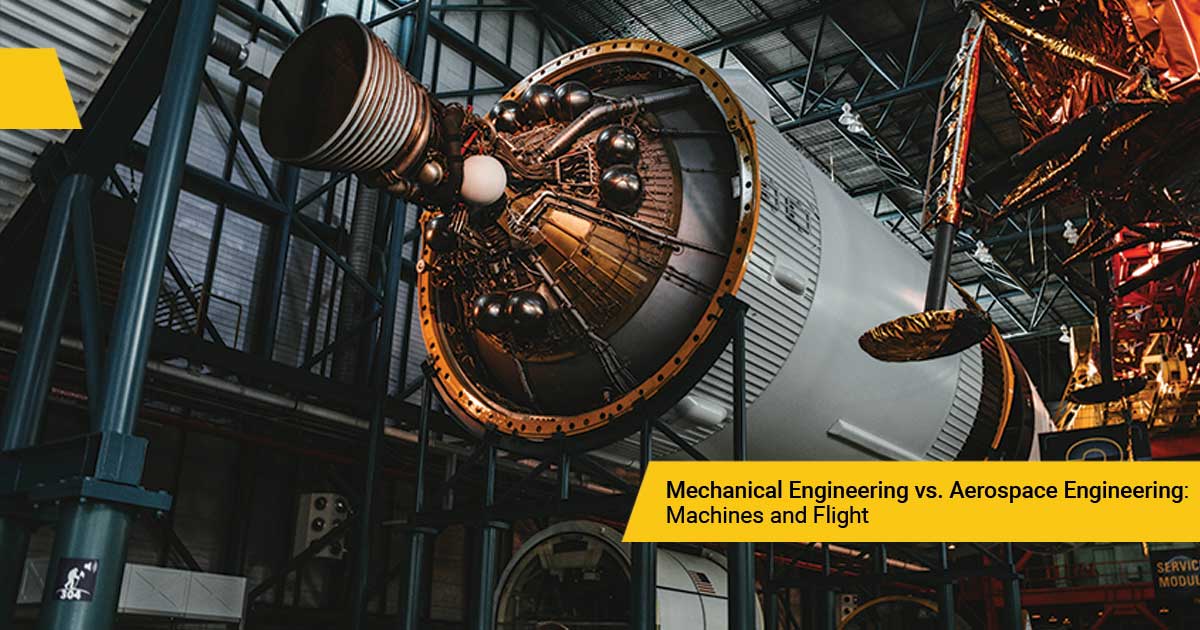FET Blogs





Table of Contents:
Mechanical and aerospace engineering are two highly coveted specialisations in the field of engineering. Although both the fields use mechanical systems and devices, the end products and systems that these two disciplines deal with are quite different. Mechanical engineering uses devices and systems for domestic or industrial purposes, whereas aerospace engineering focuses on building aircraft, spacecraft, missiles, and weapons systems. The end objective of mechanical engineering is to design, manufacture, and maintain power-producing and power-consuming machines. In contrast, aerospace engineering leverages the principles of physics and navigation to design missiles, helicopters, planes, drones, civil aircraft, satellites, and others. Our blog aims to dive deep into each specialisation and help students make an informed career choice!
Both mechanical and aerospace engineering offer undergraduate (UG) programmes such as Bachelor of Engineering (B.E) and Bachelor of Technology (B.Tech) respectively. The duration of these UG degrees is four years, divided into eight semesters. Furthermore, students have the option to pursue higher education in both disciplines by enrolling in a Master of Engineering (M.E) or a Master of Technology (M.Tech) programme. These postgraduate engineering programs extend over a period of two years, divided into four semesters.
The eligibility criteria for these two engineering degrees at the UG level require 50% marks in class 10+2 from CBSE/ICSE/State Board, or equivalent. Students who are applying should have studied mathematics, physics, and chemistry (biology, optional) in their higher secondary. However, the qualifying aggregate score is 40% in the case of SC/ST/OBC candidates. Students who possess a diploma in mechanical or allied sciences after the completion of secondary education are also eligible for direct admission. Furthermore, students need to clear national (Joint Entrance Examinations) or state-level entrance examinations (ComedK/WBJEE) to secure admissions to reputed engineering colleges.
A mechanical engineering curriculum covers a diverse range of subjects, viz., mechanics, thermodynamics, and materials science. As semesters advance, students learn specialised topics such as fluid dynamics, heat transfer, and machine design. Other areas of study comprise control systems, manufacturing processes, and structural analysis. Moreover, students have the opportunity to take up elective courses and projects in fields such as robotics, renewable energy, and automotive engineering.
In contrast, the aerospace engineering programme allows students to develop expertise in aerospace-focused subjects. Students gain insights into areas like aerodynamics, design of aircraft and spacecraft, propulsion systems, and structural analysis. The curriculum also covers areas such as flight mechanics and orbital mechanics to gain a comprehensive understanding of flight and space exploration. Furthermore, the curriculum may offer elective courses in areas like avionics, advanced materials, and space systems engineering.
Mechanical engineering is known for imparting problem-solving and innovation skills through its courses. Students can utilise their knowledge and skills to access a wide range of job opportunities in the evolving business landscape. After graduation, students can work in the automotive industry, designing, manufacturing, and enhancing the performance of vehicles. Furthermore, ample career advancement opportunities lie in the energy sector. Students can leverage their expertise in energy production, renewable energy technologies, and energy-efficient systems. On the other hand, a career in manufacturing involves supervising production processes, ensuring quality control, and implementing automation in manufacturing facilities. Students can also venture into the fields of robotics and automation, where they design robotic systems for diverse applications.
Conversely, aerospace engineering provides promising career prospects, driven by the burgeoning commercialisation of the space industry. Aerospace engineers play a crucial role in the development of aircraft, spacecraft, and propulsion systems. Furthermore, with the emergence of private space enterprises and government investments in space exploration, students can explore various areas, including satellite technology, space tourism, and planetary expeditions. Students can work as aircraft design engineers, focusing on the development of airplanes, helicopters, and unmanned aerial vehicles (UAVs). Alternatively, students can work as propulsion engineers, engaged in the development of engines for spacecraft, such as jet engines and rocket propulsion systems.
Mechanical and aerospace engineering stand as highly sought-after specialisations within the vast field of engineering. Mechanical engineering focuses on machines for domestic and industrial use, while aerospace engineering deals with aircraft, spacecraft, and related technologies. Both mechanical and aerospace engineering offer promising career prospects across various fields. Mechanical engineers find opportunities in the automotive industry, energy sector, manufacturing, and automation, among others. Conversely, aerospace engineers are in high demand due to technological advancements and the flourishing commercial space industry. These engineers play an integral role in the development of aerospace technologies, with promising avenues in satellite technology, space tourism, and others. Both fields present exciting career opportunities for students who are passionate about innovating and solving complex engineering challenges.
A1: Yes, mechanical engineers can become pilots with proper flight training.
A2: Yes, mechanical engineers can work as flight engineers with aviation training.
A3: Mechanical engineers contribute to aircraft design and manufacturing.
A4: Aerospace engineering is best for careers in aircraft and spacecraft.
A5: Aerospace engineering aligns best with pilot-related technical knowledge.
A6: Yes, mechanical engineers can pursue aerospace with further specialisation.